Paid work: Longer working hours
Between 1982 and 1994, the average hours worked by full-time workers increased from 42 to 45 hours per week, but has since dropped back to 44 hours per week in 2002.
The past two decades have seen a shift away from the standard working week to a greater variety of working hours (see Australian Social Trends 1999, Decline of the standard working week). Strong growth in part-time employment has increased the proportion of workers working short hours, resulting in a slight decline in the overall average hours worked per week. However, among full-time workers, there has been a trend towards longer working hours during the past 20 years. In addition, the working hours of many families have increased during this period, as growth in women's labour force participation has resulted in more couple families with both partners engaged in paid employment. Consequently, while some people cannot find enough work (see Australian Social Trends 2003, Underutilised labour), there is also a growing awareness of the issues associated with working long hours, and the need for individuals and family units to be able to achieve a satisfactory balance between paid work and personal, family and community life (see Australian Social Trends 2003, Balancing family and work).
Hours worked
Most of the statistics on working hours used in this article are drawn from the ABS Labour Force Survey (LFS) and the 2001 Census of Population and Housing. There may be small differences between LFS estimates and Census data, reflecting differences in collection methodology. Data on preferred working hours is from the ABS 2000 Survey of Employment Arrangements and Superannuation, while data on employees who regularly worked overtime come from the ABS Survey of Working Arrangements.
Average hours worked per week is the total hours worked per week, averaged across all people who worked one hour or more in the reference week. Those who did not work in the reference week (e.g. those on leave or rostered off) are excluded.
Average hours worked per week by families is the total combined hours worked by all employed family members, averaged across all families in which at least one member worked one hour or more in the reference week.
In the census, full-time workers are employed persons who worked 35 hours or more in all jobs in the week prior to the census (or reference week). For all other data sources used in this article, full-time workers also include those who usually work 35 hours or more per week.
Proportions of full-time workers who worked specific ranges of hours (e.g. 50 hours or more per week) are calculated as percentages of those full-time workers who actually worked 35 hours or more in the reference week. Those full-time workers who did not work in the reference week, or who worked less than 35 hours in the reference week, are excluded.
Overtime is any work undertaken outside, or in addition to, ordinary or standard working hours, whether paid or unpaid. Data on overtime relate to employees in their main job. |
Longer hours for full-time workers
Between 1982 and 1994, average hours worked by full-time workers increased from 42 to 45 hours per week. This trend levelled off during the late 1990s, and since 2000, average hours worked by full-time workers have dropped back to around 44 hours per week (45 hours for men and 41 hours for women).
AVERAGE HOURS WORKED PER WEEK
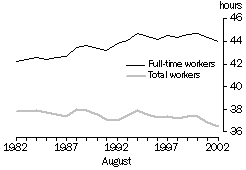
Source: ABS Labour Force Survey.
Over the same period, the distribution of full-time hours changed considerably. Between 1982 and 2002, the proportion of full-time workers working a 40 hour week declined from 39% to 24%. While this was accompanied by a slight increase in the proportion of full-time workers working less than 40 hours per week, most of the shift was towards longer working hours. The greatest increase was in the proportion of full-time workers working 50-59 hours per week (from 10% to 16%). This trend towards longer working hours was relatively uncommon among other OECD countries, most of which either experienced little change, or continued the longer term trend in reducing full-time working hours.1
DISTRIBUTION OF FULL-TIME HOURS WORKED PER WEEK
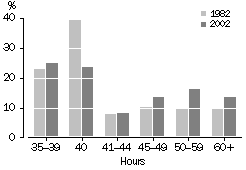
Source: ABS Labour Force Survey.
People working very long hours
The relatively small increase between 1992 and 2002 in the average number of hours worked by all full-time workers appears to be the result of a growing number of people working 50 hours or more per week. In August 2002, around 1.7 million Australians worked 50 hours or more per week, twice as many as 1982. As a proportion of full-time workers, those working 50 hours or more per week increased from 20% to 30%. The proportion of female full-time workers working 50 hours or more per week almost doubled from 10% in 1982 to 19% in 2002, and may be linked to increasing representation of women in managerial and professional occupations. That said, very long working hours remain more common among men. In 2002, 35% of male full-time workers were working 50 hours or more per week, up from 23% in 1982.
PROPORTION OF FULL-TIME WORKERS WORKING 50 HOURS OR MORE PER WEEK
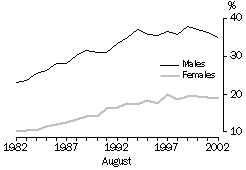
Source: ABS Labour Force Survey.
Very long working hours are more common among workers who are self-employed (i.e. own-account workers and employers in unincorporated businesses) than among employees. In 2001, 57% of self-employed workers worked 50 hours or more per week (compared with 23% of employees) while 14% of self-employed workers worked 70 hours or more per week (compared with 3% of employees).
PROPORTION OF FULL-TIME WORKERS WORKING VERY LONG HOURS - 2001
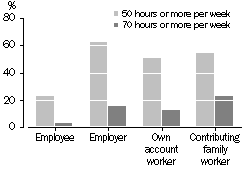
Source: ABS 2001 Census of Population and Housing.
...occupation
Very long working hours are also more prevalent in some occupations than others, and this is associated with a range of factors, many of which are closely interrelated. For example, very long working hours tend to be more common in occupations characterised by relatively high levels of self-employment in small business or private practice. Among employees, very long working hours are most common in occupations involving high levels of personal responsibility and accountability, relatively high earnings and in jobs with no standard working hours. Very long working hours tend to be less prevalent in predominantly female occupations and in occupation groups with more highly regulated working hours and conditions.
PROPORTION OF FULL-TIME WORKERS WORKING 50 HOURS OR MORE PER WEEK: SELECTED OCCUPATIONS - 2001
| Major groups and selected minor occupation groups | % |
|
| Managers and administrators | 56.0 |
 | Mixed crop and livestock farmers | 75.8 |
 | General managers | 65.0 |
 | Child care coordinators | 24.0 |
| Professionals | 29.7 |
 | Specialist medical practitioners | 64.8 |
 | Generalist medical practitioners | 56.7 |
 | Mining and materials engineers | 55.4 |
 | Secondary school teachers | 31.1 |
 | Registered nurses | 11.8 |
| Associate professionals | 36.1 |
 | Hotel and motel managers | 73.3 |
 | Shop managers | 52.2 |
 | Police officers | 18.4 |
| Tradespersons and related workers | 24.2 |
 | Plumbers | 28.4 |
 | Hairdressers | 14.5 |
| Advanced clerical and service workers | 13.6 |
 | Insurance agents | 20.2 |
 | Secretaries and personal assistants | 10.4 |
| Intermediate clerical, sales and service workers | 15.8 |
 | Sales representatives | 32.5 |
 | General clerks | 8.9 |
| Intermediate production and transport workers | 28.9 |
 | Automobile drivers | 60.4 |
 | Truck drivers | 46.5 |
 | Miners | 43.3 |
 | Sewing machinists | 12.1 |
| Elementary clerical, sales and service workers | 16.1 |
 | Street vendors and related workers | 48.2 |
 | Sales assistants | 15.9 |
| Labourers and related workers | 17.3 |
 | Mining support workers and drillers’ assistants | 52.3 |
 | Product assemblers | 5.9 |
|  |  |
| Total | 28.8 |
|
Source: ABS 2001 Census of Population and Housing.
Of all occupation groups in 2001, very long working hours were most common among Managers and administrators. Over half (56%) of all full-time workers in this group worked 50 hours or more per week, and 11% worked 70 hours or more per week. However, there was considerable variation among the specific occupations within this, and indeed all, broad occupation groups. For example, among full-time Managers and administrators, 76% of Mixed crop and livestock farmers (who are mainly males and self-employed) worked 50 hours or more per week, compared with 24% of Child care coordinators (who are mainly females and employees).
After Managers and administrators, Associate professionals were the next most likely occupation group to work very long hours. Overall, 36% of full-time Associate professionals worked 50 hours or more per week. Within this group, very long hours were most common among managerial occupations, also associated with high rates of self-employment in small business. For example, 73% of all full-time Hotel and motel managers worked 50 hours or more per week and 37% worked 70 hours or more per week. In contrast, 18% of full-time Police officers (employees working in large, relatively highly regulated workplaces) worked 50 hours or more per week.
The proportion of full-time workers working 50 hours or more per week was also relatively high among Professionals (30%) and Intermediate production and transport workers (29%). Among Professionals, doctors worked the longest hours, with 65% of full-time Specialist medical practitioners, and 57% of full-time Generalist medical practitioners, working 50 hours or more per week. While high rates of self-employment are a factor in doctors' long hours, other factors such as doctor shortages in some areas and a traditional culture of long hours among hospital interns also contribute to longer working hours for doctors.2 In contrast, 12% of full-time Registered nurses (mainly female employees working in relatively highly regulated workplaces) worked 50 hours or more per week.
Very long working hours were common in the transport industry, particularly for drivers, many of whom are self-employed. In 2001, 60% of full-time Automobile drivers (e.g. taxi drivers and chauffeurs) and 47% of full-time Truck drivers worked 50 hours or more per week. Workers in most mining occupations were also likely to work very long hours despite low rates of self-employment. For example, 43% of full-time Miners worked 50 hours or more per week, as did 52% of Mining support workers and drillers' assistants and 55% of Mining and materials engineers. This may be partly due to the prevalence of extended working shifts (e.g. two weeks on and two weeks off each month) in the more remote mining locations. As the census only identifies those full-time workers who actually worked 35 hours or more in the week before the census, the proportions of full-time workers mentioned above exclude those who worked fewer hours or who were rostered off in that week. Therefore, these figures may overstate, to some degree, the prevalence of long working hours in mining and in other occupations where similar patterns of extended shift work are common.
In general, the distribution of very long working hours across occupation groups was fairly similar for both male and female full-time workers. However, in all occupation groups, women working full-time were less likely than their male counterparts to work 50 hours or more per week. This is consistent with the fact that women, even those with full-time jobs, tend to spend more time than men on unpaid household work and child care (see Australian Social Trends 2001, Time spent on unpaid household work).
Workers' preferences
Very long working hours may contribute to work-related health problems (e.g. stress or fatigue) or difficulties in balancing work with personal or family life. These effects may be greater for those workers who are not happy with their working hours and would prefer to work less.
In 2000, 11% of employees who usually worked 49 hours or more per week in their main job preferred to work fewer hours (and earn less). A further 16% preferred to work fewer hours and earn the same. However, the majority (65%) preferred to continue working the same hours (for the same pay) while about 8% preferred to work more hours (and earn more). Of those employees who usually worked between 35 and 48 hours per week, 19% preferred to work more hours, and earn more (see Australian Social Trends 2002, Employment arrangements). This indicates that financial considerations influence workers’ preferences, and that for some workers, the opportunity to increase earnings may override other concerns associated with working long hours. However, workers who prefer to work long hours may also be influenced by other factors such as enjoyment of their work.
Overtime
A substantial proportion of Australian workers regularly undertake either paid or unpaid overtime (i.e. work outside, or in addition to, their ordinary or standard working hours). While some part-time workers regularly work overtime (12% in 2000), it is much more common among full-time workers (41% in 2000). For some full-time workers, overtime may result in a very long working week. However, not all workers who work very long hours are necessarily working overtime. For many, particularly the self-employed, whose working hours are not directly regulated by awards or agreements, the concept of standard working hours, and consequently overtime, either does not exist or is not clearly defined. For this reason, statistics on overtime are generally limited to employees. Between 1993 and 2000, there was little change in either the proportion of employees regularly working overtime, the number of overtime hours worked, or the proportion of employees working unpaid overtime.
In 2000, 2.3 million full-time employees regularly worked overtime in their main job. Among full-time employees, males were more likely than females to regularly work overtime (44% compared with 36%). Men also worked more overtime hours than women. Of those full-time employees who regularly worked overtime in 2000, 47% of males usually worked 10 hours or more of overtime per week compared with 33% of females.
The majority of full-time employees who regularly worked overtime were paid for their most recent period of overtime work. Some were paid directly by the hour (37%) while others were paid indirectly, as part of their salary package (23%), time off in lieu (5%) or by some other arrangement (2%). However, one-third of full-time employees who regularly worked overtime in 2000 reported that they had not been paid for their most recent period of overtime work. Women were more likely than men to work unpaid overtime. Among full-time employees who regularly worked overtime in 2000, 45% of females had not been paid for their most recent period of overtime, compared with 28% of males.
METHOD OF REIMBURSEMENT FOR EMPLOYEE(a) OVERTIME(b) - 2000
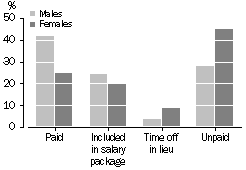
a) Full-time employees who worked overtime on a regular basis in their main job.
(b) For the most recent period of overtime worked in their main job.
Source: ABS November 2000 Working Arrangements Survey.
The prevalence of unpaid overtime varied across occupation and industry groups. In 2000, 49% of full-time Professional employees who regularly worked overtime were not paid for their most recent period of overtime. Unpaid overtime was also relatively common among full-time Advanced clerical and service workers (44% of full-time employees), Managers and administrators (42%) and Associate professionals (41%). By far the highest rates of unpaid overtime (and overtime in general) were found in education. In 2000, 62% of full-time employees in the Education industry worked overtime on a regular basis. Two-thirds of these employees had not been paid for their most recent period of overtime.
Family working hours
Increased participation of women in paid employment during the 1980s and 1990s contributed to an increase in the number of hours worked within many families. The proportion of couple families with both partners employed increased from 40% in 1985 to 52% in 2002. However, at the broad level, the effect of these trends on average family working hours has been fairly limited. This is because the increases in women’s employment, much of which is part-time, has been offset to some extent by declines in male full-time employment (see Australian Social Trends 2001, Trends in employment population ratios).
The average combined hours worked per week by all employed family members (including dependent and non-dependant children) increased from 1992 to the mid-1990s, and then fluctuated during the second half of the 1990s and the early 2000s. As with trends in individual working hours, these movements were broadly consistent with changes in economic conditions over this period. In June 2002, couple families without dependents spent an average of 62 hours per week in paid employment, almost 2 hours more than in 1992. For couple families with dependents, average working hours increased by about half an hour overall, to 58 hours per week in 2002. For one-parent families with dependents, there was an overall decrease of one hour in average working hours during the period, down to 29 hours per week in 2002.
AVERAGE HOURS WORKED PER WEEK BY FAMILIES(a)
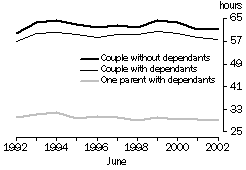
a) Combined hours worked per week by all employed family members, including dependent and non-dependant children.
Source: ABS Labour Force Survey.
Similarly, there was little or no sustained increase between 1992 and 2002 in the proportion of families working very long hours. Among couple families without dependents, the proportion working 80 hours or more per week increased from 22% in 1992 to 24% in 2002 (although reaching as high as 28% in 1994 and 29% in 1999). Among couple families with dependents, the proportion working 80 hours or more per week was the same in 2002 as in 1992 (17%), although it reached 21% in 1994 and 1999.
Endnotes
1 Campbell, I. 2002, Cross-National Comparisons: Work Time Around the World, Australian Council of Trade Unions <www.actu.asn.au/public/papers/crossnationalcomp/index-4.html>, accessed 13 January 2003.
2 Holmes, G. 1998, Junior doctors’ working hours: an unhealthy tradition? Medical Journal of Australia, Vol. 168, pp. 587-588.
 Print Page
Print Page
 Print All
Print All